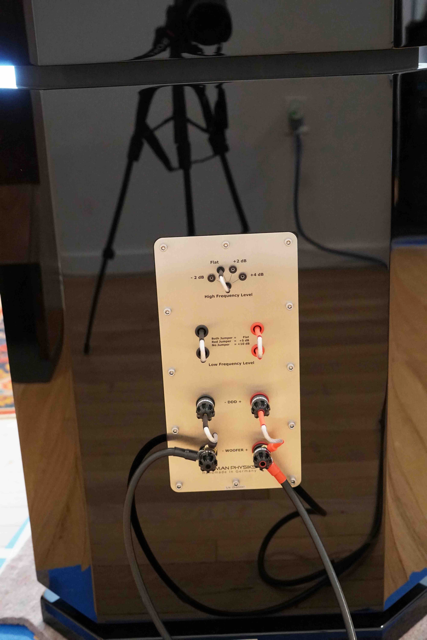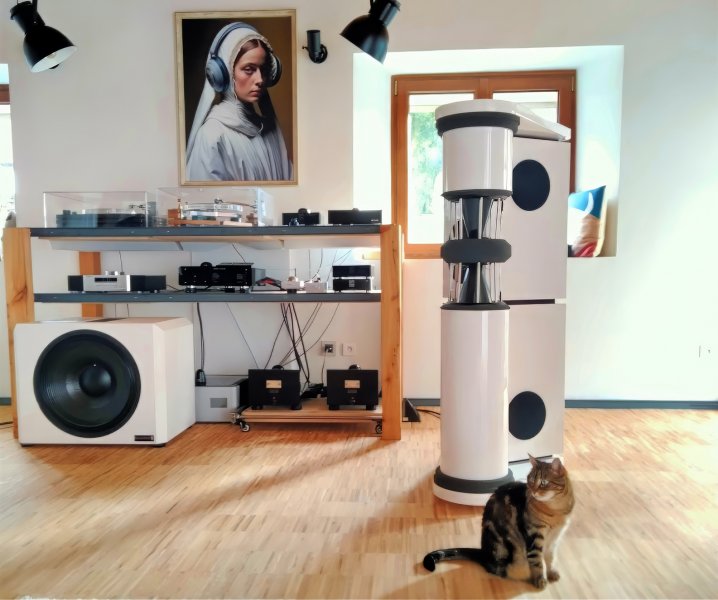Introducing the German Physiks PQS Series
I have been frequently asked what is different about the the multi driver German Physiks speakers and more specifically the PQS-302, PQS-402 and Loreley Mk III. Thus, I took the liberty to provide a small presentation of the PQS line, which I hope will be informative for our WBF members. Besides being “different” in the sound reproduction approach/design, I would like to highlight how German Physiks has addressed some real life issues in the deployment of those larger scale loudspeakers in our living spaces.
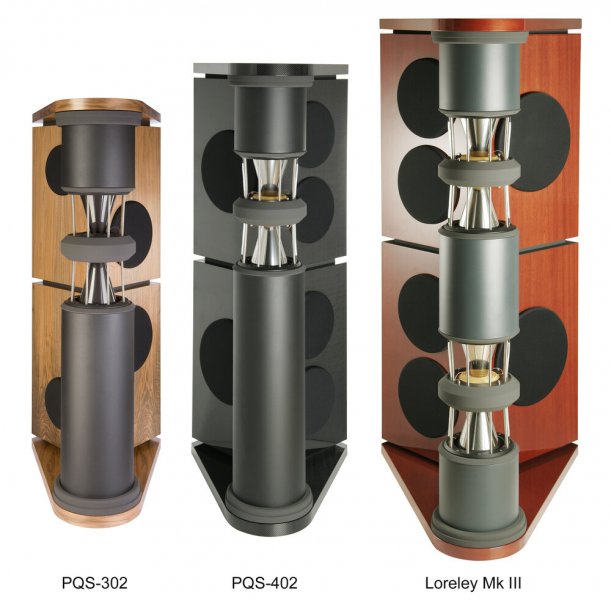
First of all, these 3 models share a common design. They came about due to a need to provide higher sound levels and drive larger rooms than it was possible with the single DDD driver models, which can produce a maximum output level of 108 dB and drive rooms up to around 900 sq ft). 108 dB is louder than many conventional loudspeakers, but to get closer to “real life” music dynamics and sound levels, we needed to go even higher. To do this, GP had to be able to move more air, which required more drivers.
Getting higher output levels from the DDD driver is achieved by simply using either 2, or 4 DDD drivers and mounting them coaxially in a vertical column on the front of the loudspeaker. Resonances in the columns, which would others colour the sound, are minimised due to their circular shape and the fact that they are made from aluminium, which is a comparatively soft material.
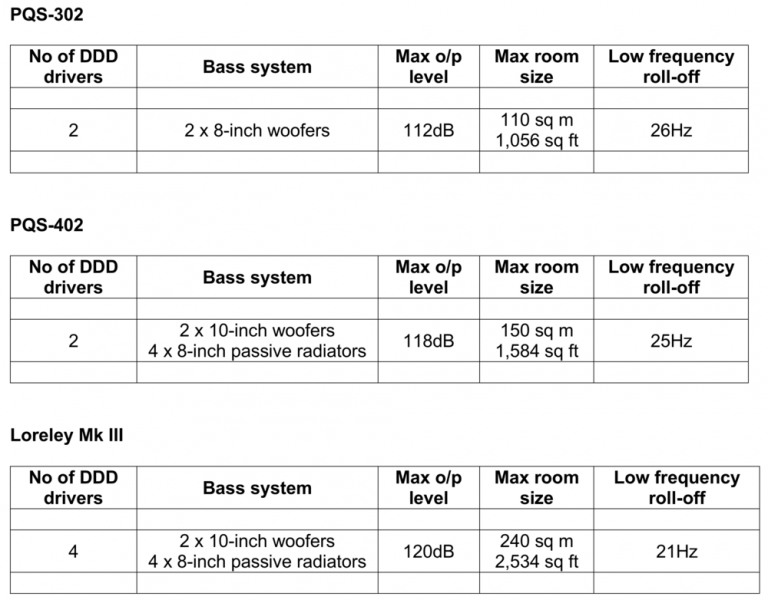
The matching bass systems require multiple drivers and this necessitates large enclosures that have to be separate from the DDD drivers. This arrangement gives considerable flexibility in the range of bass systems that may be implemented, as can be seen from the table above. You can also see that the Loreley has a very high maximum output level, as well as a very well extended bass. In a suitably large room, it can produce playback levels and dynamics that are extremely realistic.
Modular Construction
The majority of big loudspeakers on the market are made in one piece. Shipping a loudspeaker that might weigh several hundred kilograms is a challenge, as it requires very strong and therefore very expensive packing to protect it whilst in transit. Once it arrives at the customer’s home, getting it out of its packing and into position, is also a challenge – especially if it has to be manhandled up a flight of stairs, or into a small lift.
To solve this problem we adopted the modular construction illustrated below:
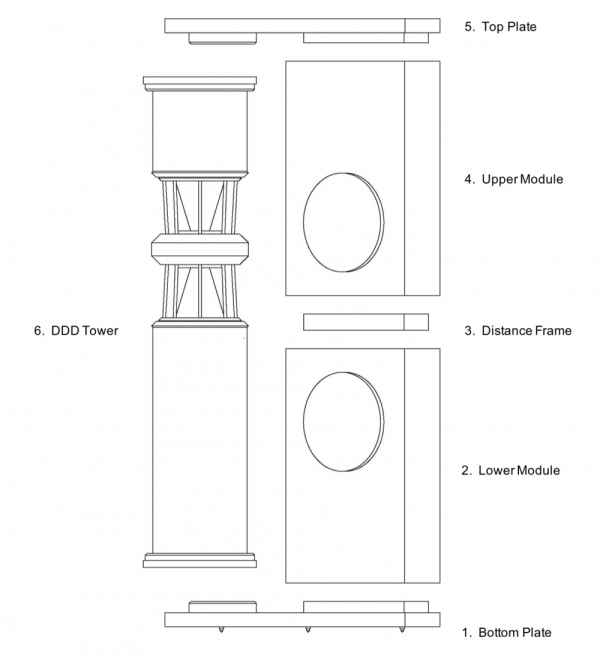
This has a number of advantages:
A veneer layer is applied to the inside surfaces of the bass cabinets to counteract stresses that the external veneer creates as it expands or contracts with changes in humidity. It is a feature you cannot see from the outside, but it ensures that even after many years of use, the external veneer will not lift and the cabinet seams will not open.
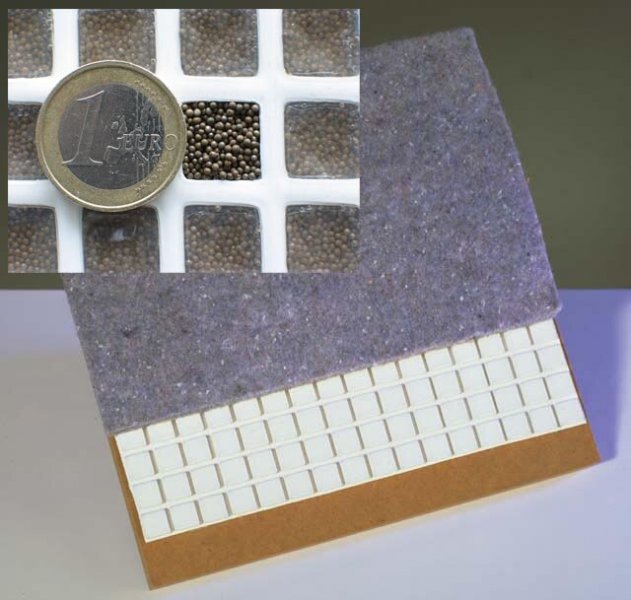
GP also applies a sound absorbing material called Hawaphon® to the inside surfaces of the bass cabinets. This a matrix of plastic cells that are filled with steel shot that very effectively convert vibrational energy into heat. This makes the bass cabinets extremely inert structures, minimizing resonances and thereby any coloration that they might produce. It was originally developed for the security industry, to be applied to the walls of a room to prevent eavesdropping from outside. It can reduce vibrations by up to 60 dB, making it a very useful tool in the loudspeaker designer’s toolbox. Furthermore, heavy acoustic felt is applied over the top of the Hawaphon® to absorb standing waves. These are also greatly reduced by the non-parallel sides of the cabinets’ vertical surfaces.
Flexibility in room positioning
Because the bass cabinets are located close behind the DDD drivers, their angled front surfaces act as diffusers for the rearward radiated energy from the DDD drivers, so these models can if needed, be positioned close to the wall. This is often the positioning used when these models are used for the main channels in home theatre systems.
Fine-tuning bass response
Once you have the loudspeakers positioned for optimum imaging, you can adjust the bass response without unduly compromising this, by simply pivoting the loudspeaker about the axis of the DDD driver column. This changes how the bass energy is reflected off the walls, but providing the DDD driver position is not changed, it has negligible effect on the imaging.
In addition, there are further adjustments in the rear of the speakers, as shown below.
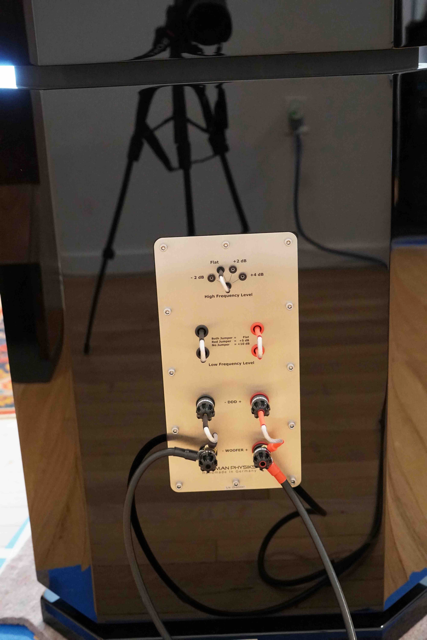
Furthermore, the loudspeakers are paired as left and right. If you have not been able to achieve the bass sound you require with the conventional positioning, you can try swapping the left and right loudspeakers over. This is something we have found useful at shows where we have had to deal with rooms with unfriendly bass characteristics.
Moving the Loudspeakers
All three of these models may be ordered with recessed casters fitted into the bass plate. These are invisible when the loudspeaker is standing and will allow even the 700kg Gaudi to be moved relatively easily when assembled – unless it is positioned on a very thick pile carpet. The pictures below show these castors on an Emperor and PQS-302 base plates.
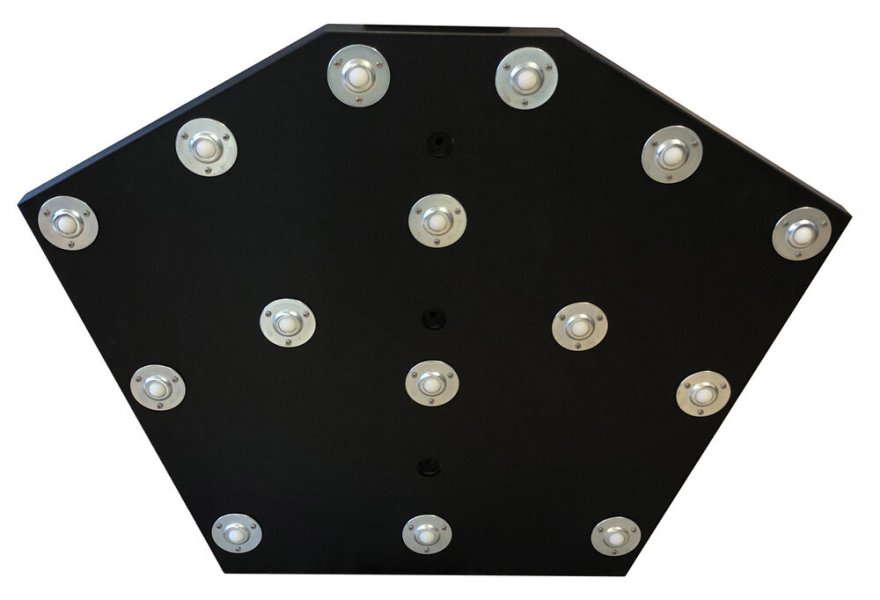
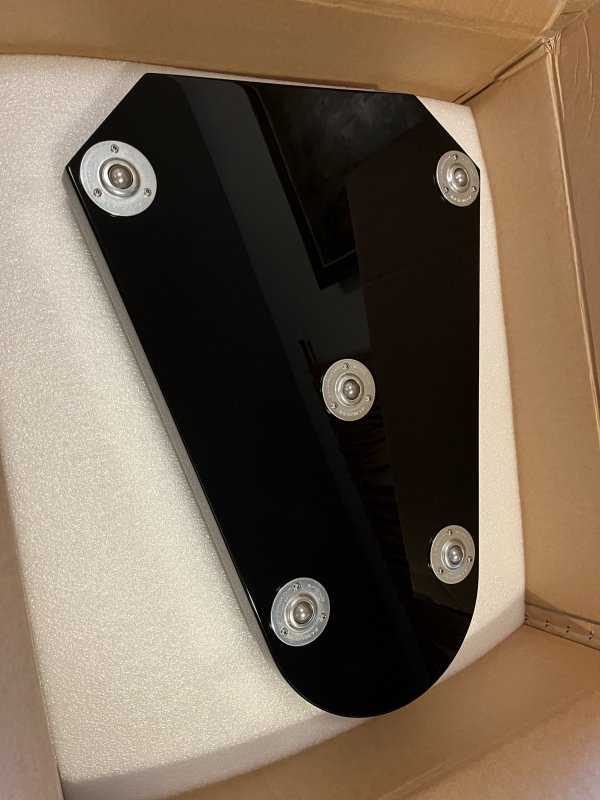
I hope I have provided a concise presentation of the German Physiks PQS series loudspeakers and its design philosophy, as well as I have answered many of the questions that frequently come up. I am available for any additional information or questions that may arise. Happy Holidays to All! Best regards, Basile
I have been frequently asked what is different about the the multi driver German Physiks speakers and more specifically the PQS-302, PQS-402 and Loreley Mk III. Thus, I took the liberty to provide a small presentation of the PQS line, which I hope will be informative for our WBF members. Besides being “different” in the sound reproduction approach/design, I would like to highlight how German Physiks has addressed some real life issues in the deployment of those larger scale loudspeakers in our living spaces.

First of all, these 3 models share a common design. They came about due to a need to provide higher sound levels and drive larger rooms than it was possible with the single DDD driver models, which can produce a maximum output level of 108 dB and drive rooms up to around 900 sq ft). 108 dB is louder than many conventional loudspeakers, but to get closer to “real life” music dynamics and sound levels, we needed to go even higher. To do this, GP had to be able to move more air, which required more drivers.
Getting higher output levels from the DDD driver is achieved by simply using either 2, or 4 DDD drivers and mounting them coaxially in a vertical column on the front of the loudspeaker. Resonances in the columns, which would others colour the sound, are minimised due to their circular shape and the fact that they are made from aluminium, which is a comparatively soft material.

The matching bass systems require multiple drivers and this necessitates large enclosures that have to be separate from the DDD drivers. This arrangement gives considerable flexibility in the range of bass systems that may be implemented, as can be seen from the table above. You can also see that the Loreley has a very high maximum output level, as well as a very well extended bass. In a suitably large room, it can produce playback levels and dynamics that are extremely realistic.
Modular Construction
The majority of big loudspeakers on the market are made in one piece. Shipping a loudspeaker that might weigh several hundred kilograms is a challenge, as it requires very strong and therefore very expensive packing to protect it whilst in transit. Once it arrives at the customer’s home, getting it out of its packing and into position, is also a challenge – especially if it has to be manhandled up a flight of stairs, or into a small lift.
To solve this problem we adopted the modular construction illustrated below:

This has a number of advantages:
- It makes it easier to ship the loudspeaker and reduces the risk of damage in transit and when handling during set-up.
- Each module is easy to handle. The heaviest modules are the bass cabinets, but these can be safely managed by just two people
- The modules fit together without the use of any screws, making assembly quick and easy. There is no danger of a screwdriver slipping and damaging a panel.
- If one of the modules get damaged, making a repair is much easier than it would be for a one-piece design, where a repair might not even be economically viable.
A veneer layer is applied to the inside surfaces of the bass cabinets to counteract stresses that the external veneer creates as it expands or contracts with changes in humidity. It is a feature you cannot see from the outside, but it ensures that even after many years of use, the external veneer will not lift and the cabinet seams will not open.

GP also applies a sound absorbing material called Hawaphon® to the inside surfaces of the bass cabinets. This a matrix of plastic cells that are filled with steel shot that very effectively convert vibrational energy into heat. This makes the bass cabinets extremely inert structures, minimizing resonances and thereby any coloration that they might produce. It was originally developed for the security industry, to be applied to the walls of a room to prevent eavesdropping from outside. It can reduce vibrations by up to 60 dB, making it a very useful tool in the loudspeaker designer’s toolbox. Furthermore, heavy acoustic felt is applied over the top of the Hawaphon® to absorb standing waves. These are also greatly reduced by the non-parallel sides of the cabinets’ vertical surfaces.
Flexibility in room positioning
Because the bass cabinets are located close behind the DDD drivers, their angled front surfaces act as diffusers for the rearward radiated energy from the DDD drivers, so these models can if needed, be positioned close to the wall. This is often the positioning used when these models are used for the main channels in home theatre systems.
Fine-tuning bass response
Once you have the loudspeakers positioned for optimum imaging, you can adjust the bass response without unduly compromising this, by simply pivoting the loudspeaker about the axis of the DDD driver column. This changes how the bass energy is reflected off the walls, but providing the DDD driver position is not changed, it has negligible effect on the imaging.
In addition, there are further adjustments in the rear of the speakers, as shown below.

Furthermore, the loudspeakers are paired as left and right. If you have not been able to achieve the bass sound you require with the conventional positioning, you can try swapping the left and right loudspeakers over. This is something we have found useful at shows where we have had to deal with rooms with unfriendly bass characteristics.
Moving the Loudspeakers
All three of these models may be ordered with recessed casters fitted into the bass plate. These are invisible when the loudspeaker is standing and will allow even the 700kg Gaudi to be moved relatively easily when assembled – unless it is positioned on a very thick pile carpet. The pictures below show these castors on an Emperor and PQS-302 base plates.


I hope I have provided a concise presentation of the German Physiks PQS series loudspeakers and its design philosophy, as well as I have answered many of the questions that frequently come up. I am available for any additional information or questions that may arise. Happy Holidays to All! Best regards, Basile
Attachments
Last edited:

















